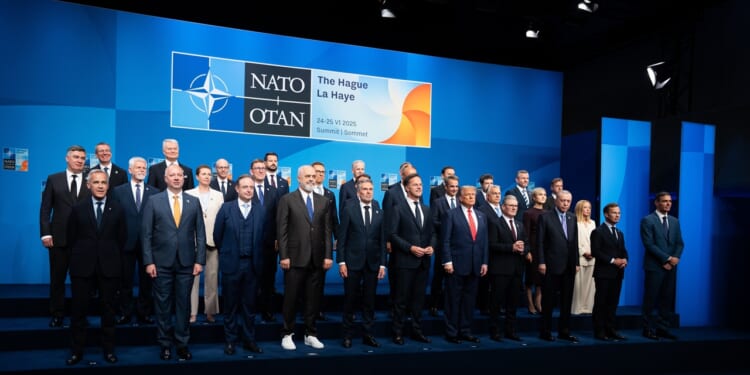With a politically realistic path, NATO can preserve President Trump’s 5 percent commitment by 2035—and raise an additional $6.3 trillion over the next decade to counter collective adversaries.
At their summit in the Hague, Netherlands, in June, the 32 members of NATO—after years of prodding from President Donald Trump—finally agreed to raise their defense spending target to 5 percent of GDP by 2035. This replaces the vague “2 percent” benchmark set at the 2014 Wales summit with a clear, uniform, and fair 5 percent. Yet that pledge alone is insufficient. NATO must adopt a politically realistic path that steadily raises annual defense spending in order to achieve two essential goals: avoiding an abrupt, politically unacceptable jump from 2034 to 2035, and raising $6.3 trillion over the next decade so that allies can strengthen collective defense immediately rather than waiting a decade.
In the past three and a half years, Russia has seized an additional 12 percent of Ukraine’s territory, bringing total control to about one-fifth of the country (including Crimea, which it occupied in 2014). Even with a best-case peace settlement, Moscow will likely retain control of many of these territories, and will remain an ongoing threat to Moldova, Georgia, Poland, the Baltics, and the rest of Europe. On August 11, David Petraeus and Clara Kaluderovic noted that China has enabled Russia’s war and is using it to prepare for a showdown with the United States, particularly over Taiwan. On August 26, Xi Jinping declared China and Russia should jointly safeguard their security and development interests.
On September 3, CNN reported Xi, Putin, and North Korean dictator Kim Jong-un had appeared publicly together for the first time at a military parade in Beijing. At the time, Trump accused the trio of conspiring against the United States. The president’s claims have merit: North Korea has supplied missiles, and Iran drones, to Russia for use in Ukraine. The joint actions of America’s adversaries heighten the urgency of strengthening NATO’s defenses.
Russia’s invasion of Ukraine reshaped NATO’s priorities. The United States, United Kingdom, Germany, Poland, and the Baltic states have boosted defense spending, but this must spread quickly to all allies—not only to hit 5 percent of GDP by 2035, but to build strength steadily in the coming decade.
Why the 5 Percent Goal Might Fall Apart
Before considering how NATO can meet its 2035 commitment, it is important to weigh the dangers of business as usual. With Trump spread thin, he may believe the 5 percent doctrine by 2035 is enough, leaving allies to follow through. But each faces political pressures, and without sustained U.S. leadership, many could succumb to competing demands and rationalize delay, consoling themselves they have until 2035—especially if interim increases aren’t required.
The consequences of the status quo are quantifiable. In constant 2022 dollars, the Peterson Institute for International Economics (PIIE) calculated NATO members’ total defense spending in 2023 at $1.28 trillion. Had all spent 5 percent of GDP, NATO’s budget would have been $2.43 trillion—a $1.15 trillion gap, roughly double today’s spending level.
In order for NATO to actually meet its 2035 commitment, it must make a plan to do so and steadily meet each step along the way. If a NATO nation makes tiny defense spending increases from 2026 until 2034, and is then faced with the prospect of doubling its defense budget in a single year, it would likely be politically unacceptable to do so. In short, without preparation and steady increases, Trump’s hard-earned victory in getting NATO allies to agree to 5 percent will vaporize—just as the 2014 “2 percent” promise largely failed after the countries that committed to it failed to implement their commitments in a systemic fashion.
The alternative is clear. NATO must adopt a realistic path over the coming decade, ensuring Trump can maintain and reinforce his hard-won 5% agreement by guiding allies through steady, incremental increases.
How a Realistic Defense Budget Increase Would Work
To design such a path, NATO’s budgets for 2026–2035 should be divided into two complementary commitments. First, each should make a base commitment maintaining NATO’s budget at the 2023 level. Second, each should also make a commitment to an annual increase, raising spending each year for two purposes: (1) normalizing annual increases so the 2034 budget transitions smoothly into 2035, and (2) providing additional funds to enhance readiness throughout the decade.
For the base commitment: PIIE reports that in 2023 the U.S. spent $880 billion on defense, or 69 percent of NATO’s $1.28 trillion total. For the remainder, a fair burden would have each member contribute 2.64 percent of GDP. At present, only five—the United States, Poland, Greece, Lithuania, and Estonia—exceed that level. The remaining 27 members are too large a majority to be willing to pay more to make it equitable. This leaves the United States to carry an extra $190 billion per year, or $1.9 trillion over the next decade. Small wonder that “America First” sentiment is so popular in the United States!
In policy debates, concrete numbers matter. Trump should argue that the United States is willing to shoulder this extra $1.9 trillion to strengthen NATO for the time being, provided allies commit to their annual increases. These increases amount to raising NATO’s total defense commitments by $115 billion every year for ten years, adding $1.15 trillion above the $1.28 trillion base to reach $2.43 trillion in 2035, consistent with 5 percent of GDP. Also, this approach would raise $6.3 trillion over the decade, funding both immediate and long-term needs.
To ensure fairness, each member’s share of the $6.3 trillion should be based on how much it must raise its current GDP percentage to reach the same 5%. For example, the U.S. would contribute $2.3 trillion, or 37% of the total, reflecting its outsized role.
In conclusion, the Trump administration should lead two efforts. First, it must ensure NATO raises spending gradually to 5% of GDP by 2035, as an abrupt doubling would be politically unacceptable and risk breaking the 5 percent commitment after a 10-year wait. Second, it should sustain the 2023 baseline budget every year while raising an additional $6.3 trillion during 2026–2035 to meet both immediate and long-term defense needs. With a politically realistic path, NATO can have the financial resources now—not a decade from now—to strengthen collective defense, deter aggression, and show that free nations can outlast and outmatch any coalition of autocrats when they plan ahead and abide by their commitments.
About the Author: Brian Chow
Brian G. Chow is an independent policy analyst with more than 180 publications, including numerous monographs, on space and other national security issues. He is a former senior physical scientist at the RAND Corporation, a role he held for 25 years. In addition to providing routine consulting services to government agencies through RAND, he was independently appointed—separate from his RAND work—as a consultant to the Office of the Chief of Naval Operations, the President’s Science Advisor, and the Under Secretary of Defense for Policy at different times, advising them on specific high-level initiatives. He holds a Ph.D. in physics, an MBA with distinction, and a Ph.D. in finance. He can be reached on X at @briangchow.
Image: Shutterstock / Cristi Dangeorge.

















